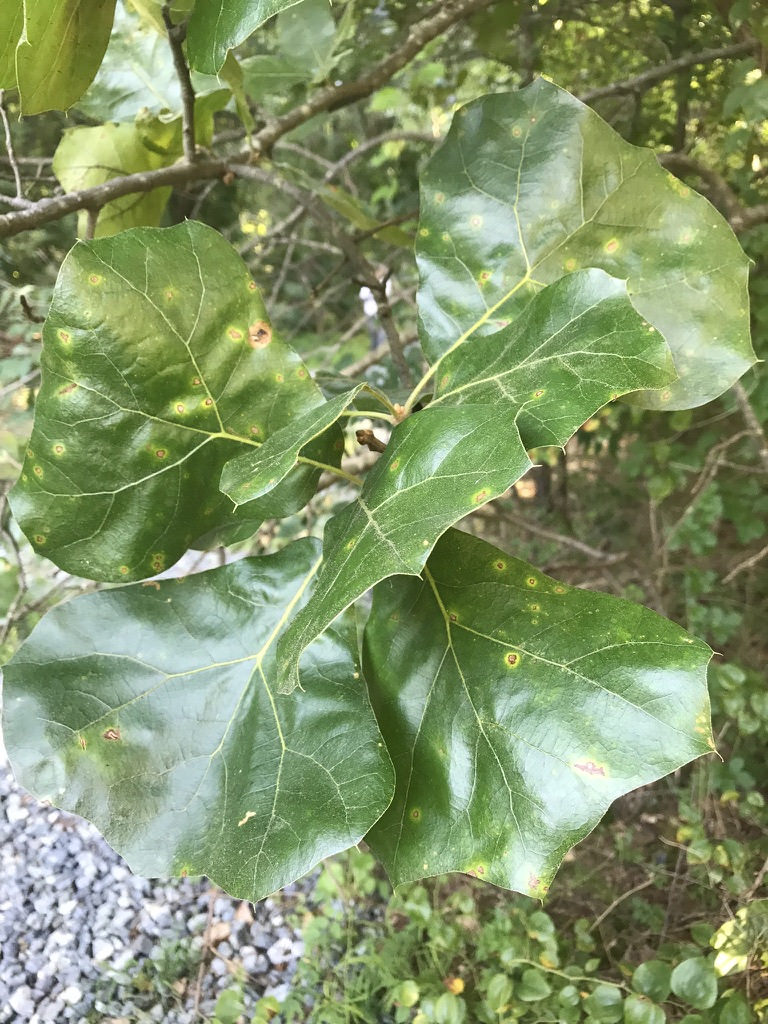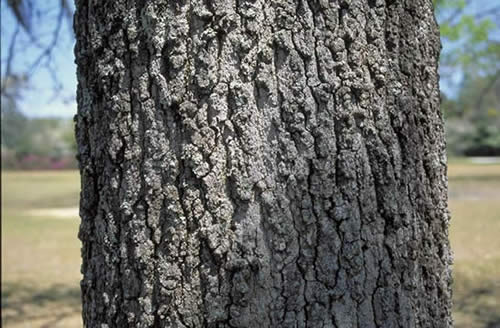Mar 17, 2019 Post oak (Quercus stellata), sometimes called iron oak, is a medium-sized tree abundant throughout the southeastern and south-central United States where it forms pure stands in the prairie transition area.
| General Information | |
|---|---|
| Symbol: | QUMA3 |
| Group: | Dicot |
| Family: | Fagaceae |
| Duration: | Perennial |
| Growth Habit: | Shrub Tree |
| Native Status: | L48 N |
| Characteristics | |
| Data Source and Documentation | |
| Native | Introduced | Both | Absent/Unreported |
| Native, No County Data | Introduced, No County Data | Both, No County Data |
| Native Status: | |||||||||
| L48 | AK | HI | PR | VI | NAV | CAN | GL | SPM | NA |
 click on a thumbnail to view an image, or see all the Quercus thumbnails at the Plants Gallery
click on a thumbnail to view an image, or see all the Quercus thumbnails at the Plants Gallery Steve Hurst. Provided by ARS Systematic Botany and Mycology Laboratory. United States, DC, Washington. Usage Requirements.
W.D. Brush. Provided by National Agricultural Library. Originally from USDA Forest Service. United States, DC, Washington. Usage Requirements.
W.D. Brush. Provided by National Agricultural Library. Originally from USDA Forest Service. United States, DC, Washington. Usage Requirements.
W.D. Brush. Provided by National Agricultural Library. Originally from USDA Forest Service. United States, DC, Washington. Usage Requirements.
W.D. Brush. Provided by National Agricultural Library. Originally from USDA Forest Service. United States, MD. Usage Requirements.
E.S. Shipp. Provided by National Agricultural Library. Originally from USDA Forest Service. United States, SC. 1927. Usage Requirements.
©Robin R. Buckallew. United States, TX, Denton. Usage Requirements.
Britton, N.L., and A. Brown. 1913. An illustrated flora of the northern United States, Canada and the British Possessions. 3 vols. Charles Scribner's Sons, New York. Vol. 1: 620. Provided by Kentucky Native Plant Society. Scanned by Omnitek Inc. Usage Requirements.
slideshow Click on a scientific name below to expand it in the PLANTS Classification Report.| Rank | Scientific Name and Common Name |
|---|---|
| Kingdom | Plantae – Plants |
| Subkingdom | Tracheobionta – Vascular plants |
| Superdivision | Spermatophyta – Seed plants |
| Division | Magnoliophyta – Flowering plants |
| Class | Magnoliopsida – Dicotyledons |
| Subclass | Hamamelididae |
| Order | Fagales |
| Family | Fagaceae – Beech family |
| Genus | Quercus L. – oak |
| Species | Quercus marilandica M端nchh. – blackjack oak |
The Plants Database includes the following 2 subspecies of Quercus marilandica . Click below on a thumbnail map or name for subspecies profiles.
Quercus marilandica var. ashei
blackjack oak
Quercus marilandica var. marilandica
blackjack oak
| More Accounts and Images | |
|---|---|
| ARS Germplasm Resources Information Network (QUMA3) | |
| CalPhotos (QUMA3) | |
| Flora of North America (QUMA3) | |
| Integrated Taxonomic Information System (QUMA3) | |
| Lady Bird Johnson Wildflower Center Native Plant Information Network (QUMA3) | |
| Native American Ethnobotany (University of Michigan - Dearborn) (QUMA3) | |
| Native Plants Network (QUMA3) | |
| USDA Forest Service Fire Effects Information System (QUMA3) | |
| USF Atlas of Florida Vascular Plants (QUMA3) | |
| University of Tennessee Herbarium (Distribution) (QUMA3) | |
Food
| Source | Large Mammals | Small Mammals | Water Birds | Terrestrial Birds |
|---|
Cover
| Source | Large Mammals | Small Mammals | Water Birds | Terrestrial Birds |
|---|
Description of Values
| Value Class | Food | Cover |
|---|
Blackjack Oak Vs Post Oak Springs
| Post oak | |
|---|---|
| The Houston Campsite Oak in Grapevine Springs Preserve, Coppell, Texas | |
Least Concern (IUCN 3.1)[1] | |
| Scientific classification | |
| Kingdom: | Plantae |
| Clade: | Tracheophytes |
| Clade: | Angiosperms |
| Clade: | Eudicots |
| Clade: | Rosids |
| Order: | Fagales |
| Family: | Fagaceae |
| Genus: | Quercus |
| Subgenus: | Quercus subg. Quercus |
| Section: | Quercus sect. Quercus |
| Species: | |
| Binomial name | |
| Quercus stellata | |
| Natural range of Quercus stellata | |
| Synonyms[2] | |
| |
Quercus stellata, the post oak or iron oak, is a North American species of oak in the white oak section. It is a slow-growing oak that lives in dry, poor soils, and is resistant to rot, fire, and drought. Interbreeding occurs among white oaks, thus many hybrid species combinations occur.
- 3Taxonomy
Introduction[edit]
Q. stellata is native to the eastern and central United States, and found along the east coast from Massachusetts to Florida, and as far inland as Nebraska.[3] It is identifiable by the rounded cross-like shape formed by the leaf lobes and hairy underside of the leaves.
Description[edit]
Post oak is a relatively small tree, typically 10–15 m (33–50 ft) tall and trunk 30–60 cm (1–2 ft) in diameter, though occasional specimens reach 30 m (100 ft) tall and 140 cm (56 in or 4.7 ft) in diameter. The leaves have a very distinctive shape, with three perpendicular terminal lobes, shaped much like a Maltese cross. They are leathery, and tomentose (densely short-hairy) beneath. The branching pattern of this tree often gives it a rugged appearance. The acorns are 1.5–2 cm (0.6-0.8 in) long, and are mature in their first summer.[5]
Taxonomy[edit]
The specific epithet stellata is Latin for 'star';[6] it is named this because the trichome hairs on the bottom of the leaves are stellate[5] or star-shaped. Several variants of Q. stellata were named by American botanist Charles Sprague Sargent. The variety most recognised by the US Forest Service is Q. stellata var. paludosa Sarg (delta post oak)[7]
Varieties[edit]
Varieties include:[8]
- var. margarettiae (Ashe) Sarg.
- var. paludosa Sarg.
- var. boyntonii (Beadle) Sarg.
- var. anomala Sarg.
- var. attenuata Sarg.
- var. araniosa Sarg.
- var. palmeri Sarg.
- var. parviloba Sarg.
- var. rufescens Sarg.
Hybrids[edit]
| Hybrid Name | Q. stellata x <sp.> |
|---|---|
| Q. × stelloides E. J. Palmer | Q . prinoides |
| Q. × mahloni E. J. Palmer | Q . sinuata var. breviloba |
| Q. × pseudomargaretta Trelease | Q . margaretta |
| Q. × sterretti Trelease | Q . lyrata |
| Q. × macnabiana Sudworth | Q . sinuata |
| Q. × guadalupensis Sargent | Q . sinuata |
| Q . × fernowi Trelease | Q . alba |
| Q. × bernardensis W. Wolf | Q . montana |
Similarity to Quercus alba[edit]
Both Quercus stellata and Q. alba are in a section of Quercus called the white oaks.[9] In the white oak section, Q. stellata is a sister taxon with Quercus alba.[10]Q. stellata is sold and distributed as white oak. One identifiable difference between the two trees is that Q. stellata is 'hairy' on the underside of the leaf.[11]
Distribution and habitat[edit]


Q. stellata is found in Southeastern United States, in the coast states from Massachusetts, to Texas, and inland to Iowa. Normally found at the edge of a forest, it typically grows in dry, sandy areas, deficient of nutrients.[11]
Uses[edit]
Because of its ability to grow in dry sites, attractive crown, and strong horizontal branches, it is used in urban forestry. It is resistant to decay, so it is used for railroad ties, siding, planks, construction timbers, stair risers and treads, flooring, pulp, veneer, particle board, fuel, and its namesake fence posts. It is used for wildlife food for deer, turkeys, squirrels, and other rodents, but because the nuts contain tannin, it is toxic to cattle.[7]
Blackjack Oak Vs Post Oak Tree
Fire ecology[edit]
Q. stellata has the ability to survive fires by having thicker bark. It is useful for fire surveys where the tree rings are used to get a fire history of an area. A tree ring survey of 36 trees in Illinois provided a 226-year tree ring record that indicated that many Q. stellata persisted through annual fire return intervals of 1.44 fires/year for over 100 years.[12]
External links[edit]
References[edit]
- ^'Quercus stellata'. IUCN Red List of Threatened Species. IUCN. 2015. 2015. Retrieved 3 November 2017.
data
old-form url - ^'Quercus stellata'. World Checklist of Selected Plant Families (WCSP). Royal Botanic Gardens, Kew – via The Plant List.
- ^'Quercus stellata'. County-level distribution map from the North American Plant Atlas (NAPA). Biota of North America Program (BONAP). 2014.
- ^illustration from Histoire des arbres forestiers de l'Amérique septentrionale, considérés principalement sous les rapports de leur usages dans les arts et de leur introduction dans le commerce ... Par F.s André-Michaux. Paris, L. Haussmann,1812-13. François André Michaux (book author), Pierre-Joseph Redouté (illustrator), Renard (engraver)
- ^ abcNixon, Kevin C. (1997). 'Quercus stellata'. In Flora of North America Editorial Committee (ed.). Flora of North America North of Mexico (FNA). 3. New York and Oxford – via eFloras.org, Missouri Botanical Garden, St. Louis, MO & Harvard University Herbaria, Cambridge, MA.
- ^Mahoney, Kevin D. 'Latin Definition for: stellatus, stellata, stellatum (ID: 35675) - Latin Dictionary and Grammar Resources - Latdict'. latin-dictionary.net. Retrieved 2016-11-16.
- ^ abStransky, John J. 'Quercus stellata Wangenh.--post oak.' Silvics of North America 2 (1990): 738-743.
- ^'Tropicos - quercus stellata Search'. www.tropicos.org. Retrieved 2016-11-10.
- ^Nixon, KC (1993-01-01). 'Infrageneric classification of Quercus (Fagaceae) and typification of sectional names'(PDF). Annales des sciences forestières. 50 (Supplement): 25s–34s. doi:10.1051/forest:19930701. ISSN0003-4312.
- ^Whittemore, A. T.; Schaal, B. A. (1991-03-15). 'Interspecific gene flow in sympatric oaks'(PDF). Proceedings of the National Academy of Sciences. 88 (6): 2540–2544. doi:10.1073/pnas.88.6.2540. ISSN0027-8424. PMC51268. PMID11607170.
- ^ abStein, John D., Denise Binion, and R. E. Acciavatti. 'Field guide to native oak species of eastern North America.' (2003): 96-97.
- ^McClain, William E.; Esker, Terry L.; Edgin, Bob R.; Spyreas, Greg; Ebinger, John E. (2010-12-01). 'Fire History of a Post Oak (Quercus stellata Wang.) Woodland in Hamilton County, Illinois'. Castanea. 75 (4): 461–474. doi:10.2179/09-007.1. ISSN0008-7475.
| Wikimedia Commons has media related to Quercus stellata. |